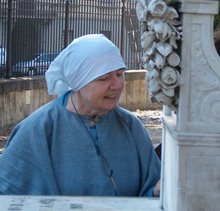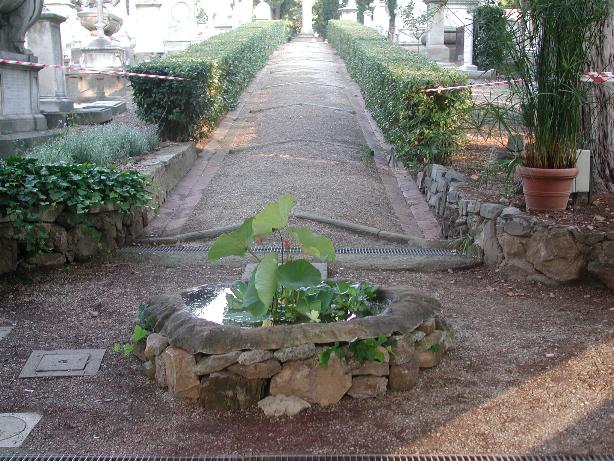
Then, in the morning at the National Archeological Museum, we simply didn't have enough chairs because so many people came and I saw everyone scurrying to bring in every chair from every office, even tall stools. The American and British Consuls were there, and the Directors of the Laurentian Library and the Riccardian Library. I was nervous about my talk in Italian but it was praised. I discussed the Diary entry by Susan Horner where she tells of drawing the winged figure of the Divinity, the sun disk, out of Champollion's book, borrowed for the purpose from the Marchese Torrigiani, for Arthur Hugh Clough's tomb.

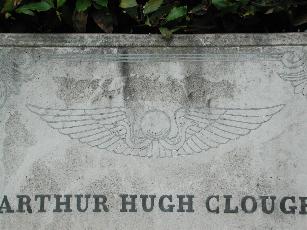
The Exhibition of the photographs of Egyptian motives on the tombs, especially this one, created by dottoressa Cristina Guidotti, is splendid and will be continuing for many months. This is the museum that has half the treasures from Champollion's and Rosellini's 1828 Expedition to Egypt and Nubia (the Louvre having the other half), and this great painting on their stairs
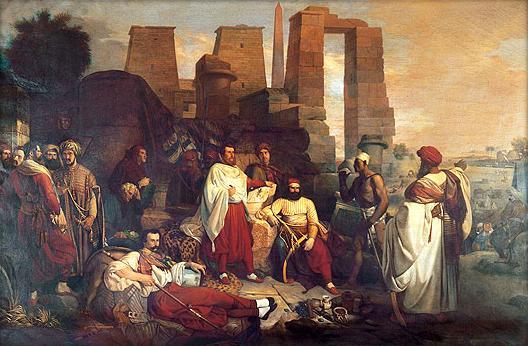
Rosellini and Champollion in Egypt, 1828, Museo Archeologico Nazionale, Firenze
Then, in the afternoon, we had the reading from Elizabeth Barrett Browning's translations from Apuleius - for which see http:://www.florin.ms/apuleius.html by Grazia Santoni and myself


where we dressed her as the Psyche in John Roddam Spencer Stanhope's painting of Psyche and Charon
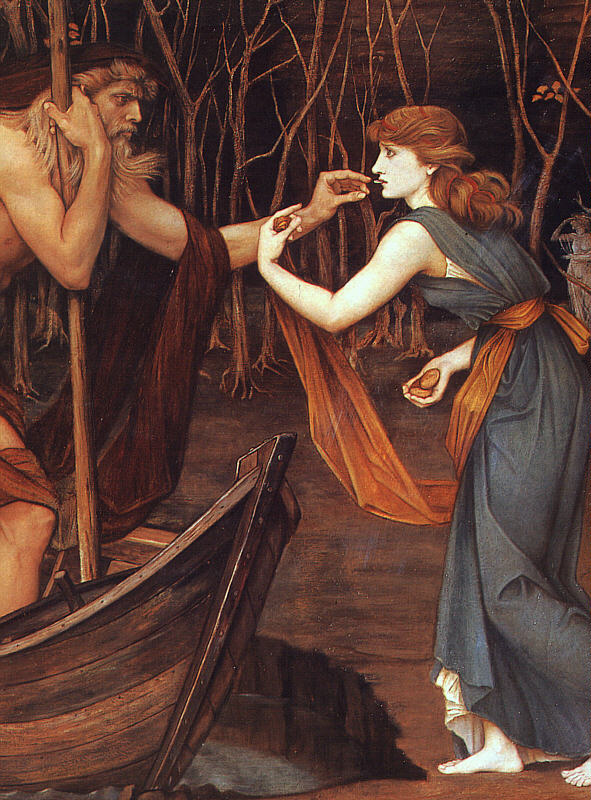
Again, as Grazia and I stood beside the great column with its cross, given by Frederick William of Prussia, and which proclaims, 'Je suis la Vie et la Resurrection', we saw crowds of people coming up the hill, as if they would never end.
In the midst of the Cupid and Psyche story I explained how many of our tombs were related to the movement against slavery in the nineteenth century and also how many important American Consuls were buried here. This is what I said, gesturing to the tombs in question, as if the Cemetery were a great book in which we could read not just Florentine, but world, history shaped by these women and men:
"When Lord Leighton designed Elizabeth Barrett Browning's tomb he put on the lyre for the Greco-Roman world the two faces of the god Pan from the statue in the Giardino Torrigiani. The other two medallions give the Hebrew harp of David with a broken slave shackle on it for freedom from Egyptian and Babylonian bondage and the Christian harp with the cross, these representing Europe’s rich multiculturalism. But also the tragedy of nineteenth-century slavery, the serfs in Russia, the blacks in America. Elizabeth Barrett Moulton Barrett’s family for generations owned slaves in Jamaica. In this cemetery are the tombs of Fanny Trollope, English, and Richard Hildreth, American, who wrote the first anti-slavery novels, paving the way for Harriet Beecher Stowe’s Uncle Tom’s Cabin. Beside the tomb of Richard Hildreth, American Consul in Trieste, is that of his fellow Unitarian, the great American preacher against slavery, Theodore Parker. Another American Consul has his large tomb here, the bibliophile James Lorimer Graham, who hosted Claire Clairmont, half sister of Mary Shelley, mother of Lord Byron’s child Allegra, and the subject of Henry James’ Aspern Papers. There are as well the tombs of Nadezhda, the black slave who came from Nubia to Florence at 14, being baptised in a Russian Orthodox family with the name ‘Hope’, and near her, that of a third American (and part Native American), Consul Hiram Powers, who sculpted ‘America’ and ‘The Last of Her Tribe’ and ‘The Greek Slave’, this last exhibited at the centre of the Crystal Palace Exhibition in 1851 and about whom Elizabeth had written this sonnet against slavery.
‘Hiram Power's "Greek Slave"’
They say Ideal Beauty cannot enter
The house of anguish. On the threshold stands
An alien Image with the shackled hands,
Called the Greek Slave: as if the sculptor meant her,
(That passionless perfection which he lent her,
Shadowed, not darkened, where the sill expands)
To, so, confront men’s crimes in different lands,
With man’s ideal sense. Pierce to the centre,
Art’s fiery finger! - and break up erelong
The serfdom of this world! Appeal, fair stone,
From God’s pure heights of beauty, against man’s wrong!
Catch up in thy divine face, not alone
East griefs but west, - and strike and shame the strong,
By thunders of white silence, overthrown!
The webpage on the 'English' Cemetery is titled 'Thunders of White Silence, from this poem and from this sculpture.
I should have mentioned that Frederick Douglass came straight from the railroad station in Florence to stand before Theodore Parker's grave, as well.
We thank so many people for this day: Paolo Bitossi, Paolo Coccheri, Assunta D'Aloi, Nora Dempsey, American Consul General, ExpoMeeting, Katherine Goldsmith, dott.ssa Cristina Guidotti, Edgar Kraft, Swiss Consul, Soprintendente Fulvia Lo Schiavo, Moira Macfarlane, British Consul General, Alison Pryce, Grazia Santoni, Vieri Torrigiani Malaspina, and Giuseppe Venturini, who is conserving Arthur Hugh Clough's tomb, and many others.
Do come and visit. Or at least virtually. For you can zoom in on the 'English Cemetery Florence' by simply typing in those words, then clicking on the place, in Google Earth. And consider contributing to the gardening, turning this back into the Paradise it once was. One person present wrote a cheque for 2000 euro with which we can begin this project, working with the Giardino Torrigiani which had supplied so many of the nineteenth-century plants that had been here. Am suggesting we begin with a pomegranate by Elizabeth's tomb, with roses on the wrought iron arches over the children's tombs (too many babies dying in the Victorian period), with myrtle on the tombs that had them, like the one that Mary Somerville had planted on her husband's grave, with lavender hedges. And meanwhile we are propagating the papyrus you see above. The Torrigiani people showed us how, placing the star frond face down in water so it sprouts roots.
We are now at 1244 signatures on the web at http://www.thepetitionsite.com/takeaction/471134975,
'That the Swiss-owned, so-called 'English' Cemetery in Florence be kept open, be restored and be declared a UNESCO World Heritage Site', and with 1700 signatures in-house from our visitors, for a total of 2944 signatures. We have decided to keep them coming. Just 66 to go for the 3000 we should like to present to UNESCO!
If you wish to donate to the Aureo Anello Association for the restoration of the 'English' Cemetery you can do so by a cheque made out to 'Aureo Anello' and posted to 'English' Cemetery, Piazzale Donatello 38, 50132 Florence, Italy; or through the Pay Pal 'Donate' button below, which can also be used for the CDs, hand-bound limited edition books and sculptures of Elizabeth and Robert's 'Clasped Hands':

Sincerely,
Julia Bolton Holloway
Aureo Anello Association for the Library and Cemetery
Piazzale Donatello, 38
50132 FIRENZE, ITALY
